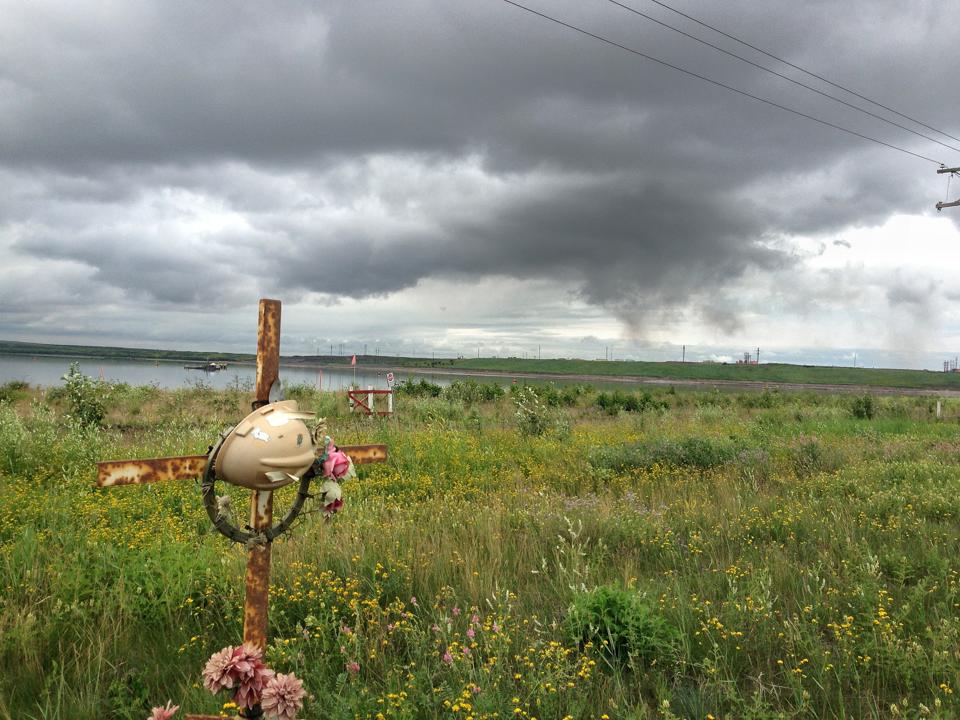Please support our coverage of democratic movements and become a supporting member of rabble.ca.
Emma Pullman is a Vancouver-based researcher, writer and campaigner. She is a campaigner with for Leadnow.ca and campaigns consultant for SumOfUs. Emma will spend the next two weeks in Fort Chipewyan, Anzac, Fort McKay and Beaver Lake meeting with First Nations elders and local residents about the impact of the tar sands on their lands and communities. This series will recount her findings and reflections until her trip concludes when she joins Aboriginal communities from across Turtle Island in Fort McMurray for the Healing Walk against the tar sands on July 5-6. Read parts one, two, three and four of the series on rabble.ca.
Some fifteen years ago, at a Peace Gathering, an elder shared a prophecy. A baby boy would be born in a teepee on a buffalo robe, his birth signalling that now is the time to act.
Last Thursday, on the eve of the 4th Annual Healing Walk in Fort McMurray, Alberta, a young woman went into labour. Her contractions came closer together. Grandmothers and mothers gathered to pray. And, at the stroke of midnight, inside a teepee, a healthy boy was born on a buffalo robe.
The baby was born on the Healing Walk grounds amidst the tents of the over 400 First Nations, settlers, workers, children and families who came together from across the world to pray for the healing of the land and people. The elders say the old prophecy is now coming true.
The following morning, another profound omen came from the skies: rain. Crystal Lameman of the Beaver Lake Cree Nation describes the importance of rain in her culture: “Rain sn a blessing. Rain is water, and that’s our mother cleansing herself. Just as we cleanse ourselves when we cry, she cleanses herself through the rain.”
Together, we set off on a 14-kilometre walk past tailings lakes, so-called “reclaimed” land and plants. In the words of Clayton Thomas-Muller, a prominent First Nations activist and coordinator of the Sovereignty Summer, the Healing Walk is “a meaningful ceremonial action to pray for the healing of Mother Earth, which has been so damaged by the tar sands industry.”
The walk was grueling. Many of us endured sore throats, headaches and stinging eyes from the pollution. We felt pain in our feet and pain in our hearts at the destruction of the land and the pain of those who have lived on this land since time immemorial.
During our 14-kilometre walk around the Syncrude Loop, the smell of sweetgrass mixed with the stench of the tailings lakes. Propane-powered cannons designed to scare birds from landing on toxic tailings lakes fired, interrupted by the sound of drums beating in unison. Voices in song and prayer rose above the sound of industry. Trucks drove past us down the highway and honked their horns in support. We were witnesses to the destruction of the land and were were a part of its healing.
We stopped to pray to the four directions. At one, the sobs of an elder echoed across the barren landscape. She sobbed for the destruction of her land. Her emotion was so raw that it brought me and many others to tears. I realized how imminent this fight is, that the fight against the tar sands is a not only a climate fight, it is a fight for the land, the water, and for the beings who can’t speak for themselves. It is a fight for human rights and for Treaty rights, and against the loss of culture.
As settlers and allies, it is our task to take these lessons home with us, and to continue to work to heal the land.
And I believe that the lessons of what we must take home with us following the Healing Walk are summed up best by a prophecy that actress Tantoo Cardinal shared with me.
She told me of the Papaschase, a group of Cree people that descended from Chief Papaschase. Part of their traditional territory is located on south side of the North Saskatchewan river in Edmonton, in present-day Strathcona. In the late 1800s, the Canadian Pacific Railway arrived in their traditional territory to build a railway. In Tantoo’s words, “the company was insistent on building where they wanted.”
Papaschase and the community tried to negotiate with the CPR to build the railway around their territory, not across it. “They tried to negotiate with them, tried to talk with them, tried to make deals with them, and the outcome of all that was that some white people came through in the night and set their tents on fire to get them out of there.”
Cardinal continues, “The young men got angry and wanted to retaliate. So, Papaschase went into his ceremony tent.” When he came out, he told them they had free will and his people could go to war if they wanted. But he cautioned, “These people, their numbers are so great — you can look as far as the eye can see from the tallest hill and it keeps going and going and going. And they have artillery, they have guns, they have tools of war that we don’t have access to. And they’re blinded and deafened by greed. There’s no talking to these people. And they’ll do whatever it takes”.
“But”, Cardinal told me, “there will be a generation of their children that will be our friends. So that’s the time to stand.”
The Healing Walk is perhaps proof that Papaschase’s prophecy is coming true as well. Settlers are starting to learn how to to stand together as allies in the fight against the tar sands.
Now is the time to stand.
This blog entry was cross-posted at The Huffington Post.
Photo: Emma Pullman



